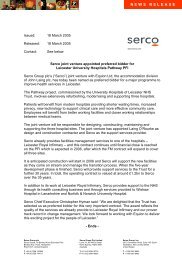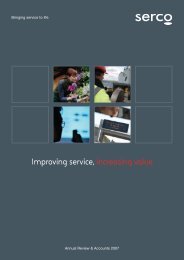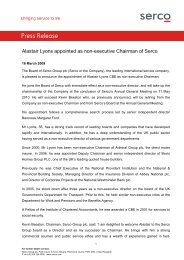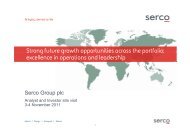Corporate Responsibility Review 2008 - Serco
Corporate Responsibility Review 2008 - Serco
Corporate Responsibility Review 2008 - Serco
You also want an ePaper? Increase the reach of your titles
YUMPU automatically turns print PDFs into web optimized ePapers that Google loves.
Community<br />
IT IS ALL TOO EASY for those on the<br />
outside to judge prisons, young offender<br />
institutions and other detention centres<br />
on the rare occasions that things go<br />
wrong – they, after all, make the headlines.<br />
And noone is denying that keeping<br />
people behind bars is a challenging,<br />
often gruelling occupation.<br />
But visitors to a <strong>Serco</strong> secure centre,<br />
whether north or south of the equator,<br />
cannot help but be struck by the sheer<br />
cheerfulness of the employees; their<br />
energy, determination and optimism is<br />
quite infectious. There is a real sense of<br />
a personal vocation, a desire to reassess<br />
conventional wisdom, to pioneer new<br />
ideas, in short to go that extra mile.<br />
While the priority must always be to<br />
ensure safety both for those inside the<br />
centres and also the public at large,<br />
<strong>Serco</strong> is also driven by the need to<br />
educate and train, to help people turn<br />
their lives around before resettling them<br />
within the community with as much<br />
support as possible.<br />
It is an entrepreneurial culture that<br />
attracts an extraordinarily committed<br />
range of people, drawn not by pay or<br />
perks – employees at <strong>Serco</strong>-run secure<br />
centres do not earn more than those<br />
in the public sector; they are, however,<br />
empowered and encouraged to innovate.<br />
Adopting a dynamic approach<br />
“We try to recruit people who are not<br />
interested in simply being static guards,<br />
but in offering dynamic security. That<br />
means actively engaging with individuals<br />
in our care to understand their motivations<br />
and their fears,” explains John Smith,<br />
Director of Change and Operations for<br />
<strong>Serco</strong>’s UK residential contracts.<br />
“We know it’s safer and better to engage<br />
with prisoners than to confront them. We<br />
encourage them to accept responsibility<br />
for their previous actions and then think<br />
seriously about how they can turn <br />
PREVIOUS PAGE:<br />
the vibrant result<br />
of a painting<br />
workshop at<br />
Acacia Prison<br />
INDIGENOUS<br />
PRISONERS AT<br />
ACACIA PRISON<br />
(RIGHT) receive<br />
skills training<br />
and tailor-made<br />
education<br />
programmes<br />
Acacia Prison, Australia<br />
Rising to the challenge<br />
■ An 800-bed, medium-security prison in Western Australia<br />
■ Adapting to assimilate Indigenous prisoners<br />
■ Providing tailor-made educational programmes<br />
The size of central Europe, Western Australia is home to<br />
no fewer than 40 Indigenous language and dialect groups,<br />
each with its own culture.<br />
So when <strong>Serco</strong> took over Acacia Prison, on the outskirts<br />
of Perth, just over two years ago, the fact that 35% of its<br />
population was Indigenous presented particular challenges<br />
and consequently the need for innovative thinking. Indigenous<br />
people account for 3% of the Australian population, but more<br />
than 40% of the prison population, an over-representation<br />
that is sometimes the consequence of high levels of social<br />
deprivation, unemployment, drug and alcohol addictions,<br />
and lack of access to services.<br />
Acacia’s Director, Andy Beck took the highly unusual<br />
step of escorting Paul Mahoney, <strong>Serco</strong> Asia Pacific’s Chief<br />
Operating Officer, and John Smith, UK Director of Operations<br />
– Residential (Home Affairs), to a remote corner of the Pilbara<br />
region to discuss with a group of Elders the problems facing<br />
their communities and how to prepare Indigenous prisoners<br />
for release. “The long journey was more than worth it,” says<br />
Andy, who has recently adopted a new approach that<br />
addresses the needs of Acacia’s Aboriginal prisoners,<br />
utilising the power of their culture to restore many of the<br />
values that underpin a strong Aboriginal society and to<br />
encourage cooperation with the prison regime.<br />
Indigenous Assistant Director Vanessa Davies has<br />
responsibility for these prisoners. “Vanessa has developed<br />
an action plan that tackles many of the major issues<br />
including poor health, low levels of education and training,<br />
and spiritual and cultural needs,” says Andy.<br />
The prison has an Indigenous Advisory Board made up<br />
of prominent Indigenous Community Leaders who offer<br />
advice and guidance to help shape relevant services for<br />
Aboriginal prisoners. Through Community partnerships,<br />
they are now offered tailor-made education programmes,<br />
delivered by skilled educational employees, including a<br />
highly respected Indigenous Elder. “The prisoners look up<br />
to the Elders, who come in for traditional story-telling<br />
sessions to help get the message across about offending<br />
behaviour and the need to turn their lives round,” says Andy.<br />
Many Indigenous prisoners have had limited access<br />
to, and are wary of, Western medicine. Yet chronic health<br />
problems mean their average life expectancy is low at<br />
around 59 years for males and 65 for females (compared<br />
with 77 and 82, respectively, for Australia as a whole).<br />
Acacia worked with the Derbal Yirrigan Aboriginal Health<br />
Organisation to bring the Marman Pit Stop to the prison.<br />
Renowned for its success in getting Indigenous people to<br />
undergo crucial health checks, Pit Stop aligns parts of the<br />
body to parts of a car and prisoners are encouraged to get<br />
their bodies ‘serviced’, something they can relate to.<br />
The obligation to attend family funerals can make<br />
incarceration particularly difficult for Indigenous prisoners.<br />
“They believe that if they don’t attend, it can result in<br />
retribution or ‘pay-back’,” he says. “Once a prisoner thinks<br />
someone has called in bad spirits as part of ‘pay-back’, they<br />
can become so fearful they literally lose the will to live. When<br />
that happens, a community Elder is brought in to conduct a<br />
smoking ceremony – burning eucalyptus leaves and reciting<br />
special words to ward off evil spirits.<br />
Acacia’s pioneering work was recognised in <strong>2008</strong> when<br />
it was ranked as one of only two high-performing prisons<br />
in Western Australia in the Inspector of Custodial Services’<br />
<strong>2008</strong> annual report.<br />
“We have given a high priority to addressing the needs of<br />
our Indigenous prisoners,” says Andy. “No other prison in<br />
the state offers programmes like ours.”<br />
“Indigenous people account for 3% of the<br />
Australian population but more than 40% of the<br />
prison population, an over-representation that<br />
is sometimes the consequence of high levels of<br />
social deprivation, unemployment, drug and<br />
alcohol addictions, and lack of access to services.”<br />
<strong>2008</strong> at a glance<br />
Acacia Prison, Australia<br />
Recognising the complex needs of its Indigenous prisoners<br />
and integrating their culture within the prison regime<br />
Borallon Correctional Centre, Australia<br />
Training prisoners to help solve a manpower shortage<br />
HMP and YOI Doncaster, UK<br />
Employing a former prisoner as a mentor to other prisoners<br />
26 | <strong>Corporate</strong> <strong>Responsibility</strong> <strong>Review</strong> | <strong>2008</strong><br />
www.serco.com | 27

















